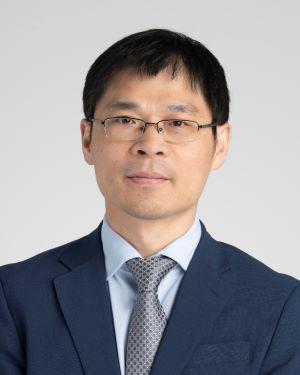Research News
03/25/2025
Combination therapy targets tumor-associated macrophages in glioblastoma
Combining PD-1 therapy with treatments blocking interactions between tumor-associated macrophages and cancer cells has a 40-50% cure rate in glioblastoma models.

A new combination therapy for glioblastoma developed at Cleveland Clinic cures cases in preclinical models 40-50% of the time – a significant step in finding a cure. The regimen combines PD-1 inhibitors with drugs that prevent tumor-associated macrophages (TAMs) from communicating with tumor cells and our immune systems.
Glioblastoma treatments, including brain surgery, chemotherapy and radiation therapy, are generally considered successful if a patient’s life is extended by a few years. Even with treatment, only 30% of patients survive one year past their initial diagnosis; 10% of patients survive five years. Although more work is needed to fully validate and optimize the treatment, study lead author Peiwen Chen, PhD, hopes his team’s Journal of Clinical Investigation (JCI) paper will result in more options for glioblastoma patients.
How do tumor-associated macrophages function in cancer?
Tumor-associated macrophages are white blood cells that can enter solid tumors. Macrophages are supposed to fight cancer cells from within the tumor, and some do. But TAMs can often “switch sides” to support tumor growth, fighting off our own immune cells instead. TAMs make up nearly 50 percent of individual glioblastoma tumors. As immunotherapy sparks immune activity to attack the tumor, the TAMs counter by suppressing the immune response.
“Glioblastoma is an immunologically cold tumor, meaning it barely responds to current immunotherapies,” Dr. Chen says. “Understanding how TAMs work to suppress normal immune function is critical in overcoming this barrier and providing glioblastoma patients with more treatment options.”
The Chen lab’s newest study, led by postdoctoral researcher Lizhi Pang, PhD, uncovered the mechanism of a major molecule driving TAMs’ anti-immunity and pro-tumor functions: LGMN.
Blocking TAM’s targets shows promise for enabling PD-1 immunotherapy
Tumor-associated macrophages in glioblastoma make high levels of LGMN. The Chen lab found two relevant signaling pathways: One aids macrophages in entering the tumor and the other promotes tumor cell growth and survival.
The team developed a combination therapy using commercially available molecules that target both pathways. When the compounds were combined with PD-1 immunotherapy, the team saw complete tumor regression in 40-50% of preclinical tests.
Treating each tumor as unique
Dr. Chen’s team recently developed a combination therapy for a different subset of glioblastoma, where the tumor is caused by mutations in the PTEN gene. This form of brain tumor required combination therapies that prevented TAMs from interacting with microglial cells. The team’s current study prevents TAMs from interacting with the tumor itself to treat a type of glioblastoma with high levels of hypoxia (low oxygen).
“Each tumor is composed of multiple types of cells that all interact with each other in different ways. These cell-cell interactions are context-dependent and unique to individual tumors,” Dr. Chen explains. “By characterizing these interactions and the roles they play in tumor progression and immunotherapy resistance, we are now at a crossroads for major advances in developing and validating novel therapeutic approaches to target these interactions in glioblastoma and cure this incurable disease.”
Featured Experts
News Category
Related News
Research areas
Want To Support Ground-Breaking Research at Cleveland Clinic?
Discover how you can help Cleveland Clinic save lives and continue to lead the transformation of healthcare.
Give to Cleveland Clinic